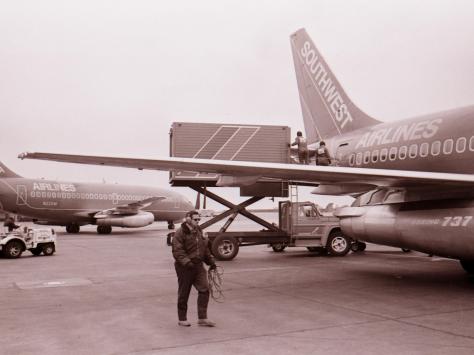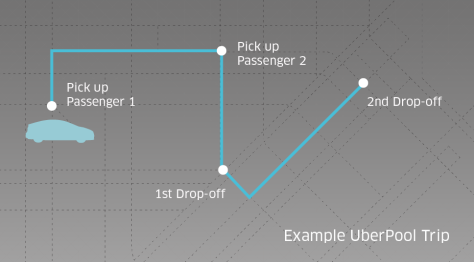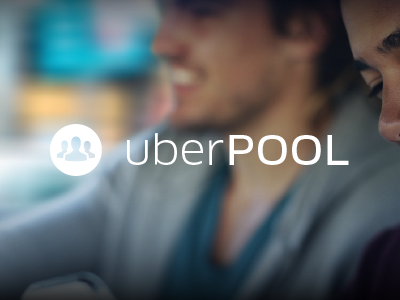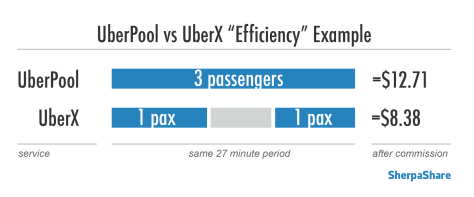For our latest post we welcome guest contributor John Sollars to share his perspective on UberPool. John also runs the blog RideshareDriver.com and we’ll be sure to include upcoming features by him on the SherpaShare Blog.
I’m a full-time driver and a veteran in the driving industry, and recently ran some of the numbers: It turns out that a driver’s compensation for UberPool rides is nearly identical as it is for UberX rides, and can often lead to higher earnings for the driver.
On the surface it might appear that the driver has to work harder for exactly the same amount of money when accepting an UberPool vs. UberX ride. Drivers earn the same mileage rate, the same rate per minute and the same base fare (for the 1st passenger) as they do for an UberX ride.
The key difference though is that UberPool rides often last longer and can therefore be a more efficient use of your time. Here’s how it looks:
The Math Behind UberPool Efficiency
Recently, in San Francisco, I completed a three passenger UberPool ride which paid $19.94. After the 20% commission and safe rides fee deduction I made $12.71.
Here’s how the UberPool fare broke down:
- Base Ride Fee = $2.50
- Safe Ride Fee ($1.35) x 3 passengers = $4.05
- Mileage Earnings (4.9 mi x $1.30/mi) = $6.37
- Time Earnings (27 min x $0.26/min) = $7.02
While $12.71 for 27 minutes of work is not exactly Uber CEO Travis type money, at $28.44 per hour it is slightly higher than my usual $25 per hour average.
I looked back at my dashboard for a similar 27 minute time frame during which I completed two uberX rides and found that for the same amount of time I only made $8.38.
Here’s how the 2 UberX fares broke down:
- First ride net (10 minutes) = $4.68
- Second ride net (8 minutes) = $3.70
- “Dead” time (9 minutes) = $0
The empty 9 minutes in between rides represents the time spent waiting for the next ride, traveling to the 2nd passenger, and time spent waiting for the passenger to come out of their house.
Those two UberX rides together netted me $8.38 vs. the $12.71 I earned for the UberPool ride taking exactly the same amount of time.
“It doesn’t take a rocket scientist to realize why UberPool in this case was more efficient. The meter was spinning from the time I picked up the first passenger until I dropped off the last.”
Focusing on Efficient Miles

In the early 1970’s, Southwest Airlines revolutionized the airline industry by introducing the “10 minute turn.” Their goal was to get their planes back into the air within 10 minutes of reaching the gate. Southwest figured out the same truth that applies to rideshare driving today.
The only time drivers (or airlines) are making money is when they are actually carrying passengers.
A plane sitting at the gate or an UberX driver sitting in his empty car outside of a passenger’s house are both examples of the same fundamental rule. When you’re idle or empty, you are not making money. As drivers, we are paid per mile and per minute. The goal should be to log as many miles as you possibly can, with the least amount of those miles unpaid or empty.
As a former Yellow cab driver in SF, I can tell you that spinning the meter at $2.75 per mile was always lucrative. Even short trips were profitable because the customary cash tips bridged the gap. Those economics are long gone. Uber and Lyft have forced the excesses out of the industry and are seemingly in a fare race to the bottom.
Today, short rideshare rides are like poison because the tips are gone, the mileage rate is so low and the time it takes to arrive, pick up and drop off passengers make them very unprofitable.
The Usual Response to Lowering Rates
Rideshare technology has consistently changed the game. The mileage rate drivers earn has dropped to $1.30 in San Francisco and below $0.90 in some other cities around the US. It’s a tough task to make a good day’s wage at those rates. As a driver, I want to keep the meter spinning, minimize empty miles and find longer trips whenever possible.
While I don’t think $1.30 per mile is good, I am able to earn a decent day’s wage in the market I drive in when I have large volume. UberPool increases my volume and more importantly, negates the effect of empty minutes between rides.
The Efficiency of UberPool

When drivers answer an UberPool request, just as with UberX, the sooner we arrive and pick up a passenger the sooner the meter starts. UberPool rides differ in that drivers have multiple passenger pickups and drop-offs, however the meter starts from the time a driver picks up the first passenger and runs until they drop off the final one.
UberPool rides are usually not short rides that pay $3.20. They are seldom under $15 and often above $25.
Savvy drivers who can manage up to 3 or 4 pickups and drop off destinations can do nothing but profit from these rides. Uber is happy because they earn a better margin while paying drivers the same basic rate per mile. Riders are happy because they individually pay about 80% of the normal fare. Drivers are happy because a 3 passenger ride ends up being a long ride while staying within the target market.
The Downsides of UberPool
There are some negative factors that drivers perceive with UberPool. Managing multiple pickups and drop-offs can be confusing to some drivers. More rides would be available if passengers all used UberX instead. Passengers are also sometimes upset when new passengers appear in their Uber as they didn’t realize they requested an UberPool ride.
UberPool vs UberX: What should I focus on?
Concentrate on your efficiency as a driver. Learn to call or text these passengers as part of your methodology in getting them out of the house and into your vehicle.
UberPool passengers tend to come outside quicker for two reasons: First is the two minute “wait rule” of UberPool versus 5 minutes for UberX. The second is that riders want to avoid harsh feelings (read: peer pressure) from fellow passengers and not keeping them waiting. They don’t have those same pressures when it’s just the driver.
I know many drivers don’t like UberPool. One driver used the term “perpetual ride.” To these drivers, I say, “Please–please give me a perpetual ride. Let my meter spin.” Uber is correct in stating that we do make more from these rides.
I can’t tell you how often I have picked up two passengers from a similar location, dropped one off halfway across town and the second all the way across town. UberPool rides are seldom short trips. The market has trended to include these types of rides and the savvy driver should understand how to adapt to this.
If you want to opt-out of UberPool, you’re out of luck. Currently, drivers can not opt out of UberPool. It is a feature of the service in some markets. If you wish to drive for Uber, you will need to do these rides. So the lesson is: Learn to adapt and embrace UberPool.


Uberpool not make sense, just idiot drivers take uberfool
LikeLike
Some drivers make fairly good money with Uber. My dashboard is above $60,000 for the year. While that is not software developer type money, it is more than enough to live comfortably. Income is often driven by the market you work in, but your efficiency and methodology as a driver largely determines how much money you make.
LikeLike
You full of shit
LikeLike
This analysis is flawed in several ways. The truth is that whether or not Uberpool increases earnings for drivers depends on the assumptions you make. Of course if there is a lot of dead time between rides, a driver would be better off doing a longer Uberpool. But in the real world, when it’s busy enough to have a 3-party Uberpool, you’ll probably be getting back to back rides with limited dead time, and you’ll earn more from those rides.
Keep in mind that the first minute of every ride is the most profitable because it includes the base fee. You don’t get those base fees on additional pickups on Uberpool. So you’re really trading off more time on the meter with Uberpool vs more profitable rides on UberX.
Also,contrary to what the author said, short rides are more profitable than long ones. That’s because you’re not driving a taxi where the goal is to maximize $/hour; you’re driving your own car, which has a cost/mile. So the proper way to measure profitability is $/mile. Anyone who has ever done a long trip with deadhead return understands this.
When it’s busy, Uberpool combines short trips into less profitable longer ones. If you’ve ever done a 2-party Uberpool with a fare of less than $10 you’ve experienced this.
Uberpool works the same way as a fare reduction. The average rider is paying less per trip because Uber is passing most of the efficiency gains of combining rides to the rider. Meanwhile, the driver is getting more trips, doing more work, and earning about the same as before. Sometimes a little more, sometimes less.
By the way, if Uberpool were truly a net benefit to drivers, they wouldn’t need to be forced to do them.. .
LikeLiked by 1 person
As Rideshare becomes more sophisticated, the concept of the “Seat-mile” (revenue/mile) is something that ought to become a part of every Rideshare driver’s vocabulary. Thanks for the post.
LikeLike
Rideshare drivers do much the same job as taxi drivers–we can greatly benefit from adapting to a cab driver’s mentality.
LikeLike
Gene,
Let me qualify the article by adding “based upon market conditions” because whats true in SF, may not be in Denver or Phoenix, etc… Your perspective is far different from mine, but I won’t say yours is flawed. What I will say is that drivers earn less money from short trips. All shifts worked include non paid miles spent arriving at a passengers location, time spent waiting for the pax to get in your vehicle, and of course, time between rides. When you divide this time into a $7 short ride Vs a $15 longer ride, I prefer the math from the longer ride. Having completed near 12,000 rides, and 5,000 this year, I trust my gut feel–UberPool pays significantly better than UberX in my market.
LikeLike
John, To each his own. I think the difference of opinion has a lot to do with how you measure your earnings. Would you rather do one $30/30 mile Uberpool trip per hour, or two $12/ 6 mile Uber X trips per hour? If you’re a cabbie, you’d rather have the $30/hour than the $24/hour. But if you own your own car, you need to consider expenses to have a true idea of profitability. And the two UberX trips, even though they paid less, are more profitable, because you got $24 for driving 12 miles, or $2/mile, whereas the Uberpool trip paid you $1/mile. In the short run, the difference seems trivial, because the only expense you see is the extra gas. But the full accounting cost of driving a car is typically around $0.50/mile. So if Uberpool reduces your average $/mile from $1.50 to $1.00, it’s actually cutting your profits in half. The extra earnings from Uberpool are an illusion. Just like the extra “earnings” you get from a fare reduction. You get a little more money for driving a lot more miles. In other words, you aren’t really earning more, it just feels that way.
LikeLike
My only observation is that in Uberpool, each rider Does pay the ‘base’ fee, it is not eliminated as Gene suggests.
LikeLike
Perhaps it’s different in different markets, or maybe we’ll need screen shots to settle this, but I’ve seen many trip statements where the payout amount for the second rider was not only less than the minimum fare, it was also less than the base fare. Can you show me am Uberpool trip that includes multiple base fares?
LikeLike
Sure, you can’t “opt-out”, but you sure as hell can accept/cancel right away. That’s what I do. I’ll never do another Uberpool ride, and I’m fine with that.
LikeLiked by 1 person
John,
In Los Angeles there is no base fare to start. Last night after reading your article I want to see if your math was right. Sadly, in the Los Angeles market your math does not add up. In total my Uberpool ride was 26 mins, with two passengers from Hollywood Bl. and Wilcox Ave (pax 1) and Cahuenga Terr and N Cahuenga Bl. (pax 2)
Math
Total Fare= $12.92
pax 1 26mins x .18=$4.61
pax 1 6.66 miles x $1.00= $6.66
Pay to me= $9.04 minus rider fee and uber fee included
Dead time= 5 mins
Total Fare= $9.92
pax 2 15mins x .18= $2.70
pax 2 5.56 miles x $1.00= $5.56
Pay to me= $6.62 minus rider fee and uber fee included
Total to me for an UberPool on 12/29/15 = $15.66
Same Ride with UberX estimated from pax 2 pick up and drop off was $31.50.
UberX ride would pay me $23.88.
Making the Uberpool ride a loss to me of $8.82
I know taking Uberpool rides are part of the deal with working in the rideshare business, but I would prefer UberX rides over Uberpool. My dollars per/mile are higher with the UberX rides with just a little patience.
Thanks for the article.
LikeLike
I agree ,I rather drive Uberx especially in LA I have 9 short trips within 37 minutes and 15 miles hardley any dead time in between I got the base pay net $3.20 ×9=28.80 I think that is good enough for me
LikeLike
That’s exactly right. Your $/mile will almost always be higher with UberX. That’s because, as I said above, the first minute of every ride is the most profitable, and Uberpool combines more profitable shorter rides into less profitable longer ones. As long as you stay busy, you’ll do better with back to back UberX rides.
LikeLike
Nice article – but in Washington DC the rates for Pool and X are different – less for Pool
X – Base $2.00 Per Mile $1.02 and Per Minute $0.20
Pool – Base $1.40 Per Mile $1.07 and Per Minute $0.15
Pool is a loser except on a minimum fare ride
LikeLike
I am in South Florida where half the population consists of scam artists. Couples living together are using UberPool when they go to dinner together. The driver picks them up together and drops them together. There are no additional miles. Just a lower fare.
LikeLiked by 1 person
Total BS.
First you include “safe ride fee” x 3 in your analysis. Don’t know about you, but u never see a some of that. It’s just another way for Uber to get more money cause it’s zeroed out of every one of my weekly pays.
Second,whether or not a passenger realizes they picked uberpool or not, If they get upset over this through no fault of my own, guess who gets the ding on the bad rating? Uber? Hell’s no! Must be my fault right?!…. Wrong! But does Uber take this into account?! Nope! Uber never acknowledges fault for anything! Even calculation errors of ratings on their own end. They can’t / won’t even do basic math to prove numbers when you ask them to. Just canned responses with no success substance. I get more information from an automated service running off a raspberry pi!
Third, there is more liability exposure when I have a series of strangers all in a car together. So let me get this straight. Uber says you can’t have a friend or other person riding along with you when you first start out, for after reasons, customer service, etc…. Blah blah blah… Granted and understood. I would want to share a ride with strangers I don’t know other than the driver. But as long as Uber gets their cut it’s all good now?! BS
Fourth, I can’t opt-out, yet I’m not an employee, I’m a private contractor but at the same time I have no choice in my own business decisions. And if I “choose” not to pickup and Uberpool ride this negatively affects my acceptance rating which is grounds for de-activation (Aka Getting Fired)?! So other than me incurring all the risks, all the costs of gas, maintenance, liability, my self-employment taxes etc…. How exactly does this differ from being an employee?! It’s my car, my choice, my business (according to Uber)… But remove choice from the equation and what do you get?……… AN EMPLOYEE!!! NOT A PRIVATE CONTRACTOR!
Just another reason to switch over to lyft exclusively, at least until they follow suit!
LikeLiked by 1 person
As far as the extra wear and tear side of this argument, and your “cost per mile” being $.50 per mile… If that’s the case, you’re doing it wrong in the first place! You DO NOT want to be using a newer vehicle that is depreciating to drive Uber. I bought a vehicle as close to the edge as is allowable in my area in terms of age (10 years in Seattle), and I will suffer close to zero depreciation no matter how many miles I pile on because it’s already lost all its value. I may be able to sell mine for more than I paid because I got a good deal. Worst case, maybe $500-1000 less after piling unlimited miles on it. You can’t be driving a car that’s going to lose $5000 or $7000 dollars a year for the miles you pile on. It destroys the profit entirely.
I understand being in a tight spot and having to start with a car you already own, even if it is poorly suited to the task… But if you’re going to continue to drive Uber you need to buy an old Prius for X driving, or an old Minivan for XL. That’s that.
My total cost per mile is probably going to come in at under $.20 per miler, and that is almost entirely gas. Even if something major does break (like a blown tranny) on top of regular minor stuff that goes wrong on a 100K+ vehicle I’d probably still come in at way under $.30 a mile for sure… Hence I’ll be no worse off than if I had a newer lower mileage vehicle which may need less maintenance. Realistically I won’t have a tranny blow, so I’ll be waaay ahead. It would be IMPOSSIBLE for me to spend anywhere close to $.50 a mile for maintaining my Minivan.
Right tool for the right job. Buy an old car and your REAL profit will soar by beating that into the ground instead of your main vehicle. If you’re in the lucky position of choosing (not already in a vehicle with payments) don’t buy into the foolish idea that you want/need a newer car. A $6000-7000 2007 or whatever Prius is what the doctor ordered, not one at twice that price which will only be worth $6000 by the time you’re done with it.
LikeLiked by 1 person
Well stated. I’d add, buy a salvaged vehicle if you are driving Lyft. Uber however doesn’t allow salvaged vehicles (although some do just cover the salvaged part on registration).
LikeLike